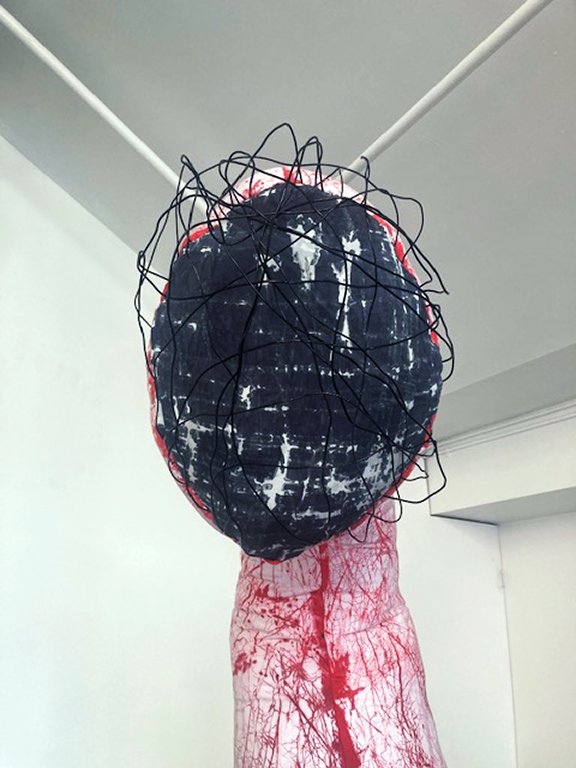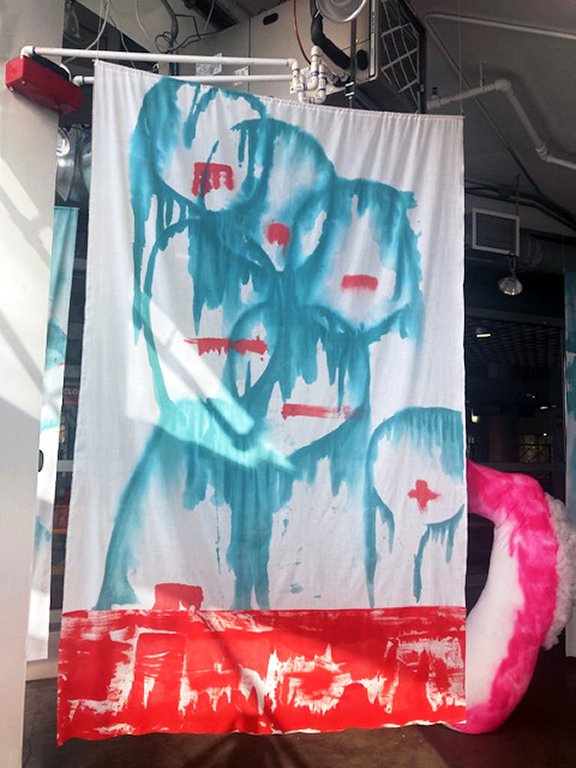We Will Be Strange
Tricia Waddell: We Will Be Strange
Understudy
890 C 14th Street, Denver, CO 80202
August 30–October 6, 2024
Admission: free
Review by Dani/elle Cunningham
Understudy Art Incubation Space has a unique, fishbowl-like design, with floor-to-ceiling windows that invite passersby to either observe art from the outside or physically experience it inside. Enhanced by the gallery’s compact layout, Tricia Waddell’s immersive solo exhibition, We Will Be Strange, emphasizes phenomenology, a philosophy that focuses on how the body shapes perception.
An outside view of Tricia Waddell’s exhibition We Will Be Strange at Understudy in downtown Denver. Image by Third Dune Productions, courtesy of Understudy.
Once inside, visitors are compelled to navigate around four large, otherworldly soft sculptures while dodging suspended fabric panels and engaging with sonic elements. These direct their bodies into closer interaction with specific spaces that dissolve the boundary between viewer and artwork. Drawing from her personal narratives, Waddell invites viewers to confront and transcend disconnection, alienation, and otherness with honesty and empathy.
A view of the title wall in Tricia Waddell’s exhibition We Will Be Strange. Image by Third Dune Productions, courtesy of Understudy.
Shaped by her fashion design background and thirty years of journaling, Waddell’s sculptures serve as introspective, non-representational self-portraits—conceptual vessels into which she has funneled parts of herself. [1] While they look similar as if they are from the same cryptid species, each one features a distinct, armor-like element, suggesting their self-protective nature. [2]
An installation view of Tricia Waddell’s exhibition We Will Be Strange. Image by Third Dune Productions, courtesy of Understudy.
Visitors viewing the sculptures up close may connect with their scale, which is comparable to the size of an average standing adult, and their playful, abstractly painted bodies. They seem weighted, with their hunched bodies eliciting a visceral response that evokes animism and suggests the artist’s physical reaction to trauma. Their decorative surfaces encourage looking and interaction, while their postures are disturbing, enticing as much as they repel, collapsing dualities, and transforming the intangible impacts of trauma into palpable, artistic forms.
Tricia Waddell, Make the world where I belong, linen, assorted papers and fabric scraps, handwritten journal pages, and cellophane, 2024. Image by Third Dune Productions, courtesy of Understudy.
A sculpture near the gallery entrance, titled Make the world where I belong, is layered at its base in cellophane, embroidered fabric, and journal pages, signifying Waddell’s innermost thoughts as well as displaying tangible, written products from her psychic archive. Its taut, white, skin-like fabric gives it a monumental presence, while thin branches on its head resemble hair or antennae, as though it is communicating with a higher realm or home-world.
A detail view of Tricia Waddell’s Make the world where I belong, linen, assorted papers and fabric scraps, handwritten journal pages, and cellophane, 2024. Image by Third Dune Productions, courtesy of Understudy.
Its voice comes in the form of a sound component created in collaboration with Ben Coleman. Soothing wind chimes, bird calls, and other nature sounds project from an internal speaker, fueling the exhibition’s immersive qualities while extending our imaginations beyond the three-dimensional world.
Tricia Waddell, Crawled Inside, linen hand painted with fiber reactive dye, encaustic wax, wire, speaker, and sound, 2024 (left). Tricia Waddell, Hanging panel, cotton voile, and rayon fabric hand painted with fiber reactive dyes, 2024 (right). Image by Third Dune Productions, courtesy of Understudy.
Another sculpture called Crawled Inside offers a scratching soundscape in counterpoint to the former’s birdsong. Its emissions are accentuated by a wire-covered, harsh, and unwelcoming face, which is both shielded and restrained, paradoxically inhibiting its ability to interact with the world.
A detail view of Tricia Waddell’s Crawled Inside, linen hand painted with fiber reactive dye, encaustic wax, wire, speaker, and sound, 2024. Image by Dani/elle Cunningham.
The sculpture emerges from an area of the gallery where the ceiling is its lowest, transforming that non-descript corner into a defensive location from which the stooping creature seems prepared to pounce. A thick ring of red paint rises from the floor and intersects with red lines on its smooth fabric surface, enhancing the tension and complexity of its mask-like face and jarring posture.
Tricia Waddell, Psychic Disturbance, linen, fabric spray paint, textile paint, handspun yarn, stuffing, and weighted beads, 2024. Image by Third Dune Productions, courtesy of Understudy.
In Psychic Disturbances, Waddell crafts a curved, soft structure painted with a vibrant pink gradient that transitions from pale white at the front to a deep hue at the head. A cottony exoskeletal spine protects it from a rear attack.
A detail view of Tricia Waddell’s Psychic Disturbance, linen, fabric spray paint, textile paint, handspun yarn, stuffing, and weighted beads, 2024 (foreground); Hanging panel, cotton voile, and rayon fabric hand painted with fiber reactive dyes, 2024 (background). Image by Third Dune Productions, courtesy of Understudy.
Like the other sculptures, its head bends downward, and is adorned with cascading, wildly tangled materials that evoke freedom and nonconformity as well as the previously explored themes of repulsion and attraction. It's as though any hand that might reach out to touch it could be sucked inside. This tension between allure and danger through physical interaction compounds the viewer’s visceral experience, blurring the boundaries between self and other.
Tricia Waddell, I am domesticated, linen hand painted with fiber reactive dye, hand embroidery, waxed thread, and paper, 2024. Image by Third Dune Productions, courtesy of Understudy.
A detail view of Tricia Waddell's I am domesticated, linen hand painted with fiber reactive dye, hand embroidery, waxed thread, and paper, 2024. Image by Third Dune Productions, courtesy of Understudy.
A final sculpture, I am domesticated, launches stiff, nebulous, and chaotic waxed red threads across an invisible cavern to connect directly to the gallery entrance. As with all the sculptures, this one features a protective element that also reaches out, suggesting a desire to relate despite feeling othered or alienated. Unlike the other works, it leans backward, its head moving away from the large front window as its red painted body recoils. Perhaps being the first point of contact for visitors has left it cautiously defensive.
Tricia Waddell, Hanging panel, cotton voile and rayon fabric hand painted with fiber reactive dyes, 2024 (foreground); Psychic Disturbance, linen, fabric spray paint, textile paint, handspun yarn, stuffing, and weighted beads, 2024 (background). Image by Dani/elle Cunningham.
Interspersed among the sculptures, suspended panels of thin, dye-painted fabric hang from the gallery’s HVAC system, adding verticality to the mostly eye-level exhibition. These panels compound the exhibition’s phenomenological underpinnings by forcing visitors to crane their necks and move awkwardly to view them.
A detail view of Tricia Waddell's Hanging panel, cotton voile and rayon fabric hand painted with fiber reactive dyes, 2024. Image by Third Dune Productions, courtesy of Understudy.
One notable panel in the middle of the gallery depicts ghostly figures melting together in cool teal with red accents, their blurred forms and smudged expressions generating feelings of being an outsider, watched by a collective of eerily obscured eyes. Bold red strokes at the bottom ground the ethereal upper section, intensifying the tension and disorientation of these indistinct identities and their paranoid effect.
An installation view of Tricia Waddell's Psychic Disturbance, linen, fabric spray paint, textile paint, handspun yarn, stuffing, and weighted beads, 2024, and Hanging panel, cotton voile, and rayon fabric hand painted with fiber reactive dyes, 2024. Image by Third Dune Productions, courtesy of Understudy.
Waddell’s immersive journey through otherworldly soft sculptures, suspended painted fabrics, and peaceful audio components highlights the artist’s dynamism. From these elements, the artist masterfully intertwines personal narrative with universal themes of isolation, memory, and healing, using her work to welcome viewers’ physical interaction and deepening emotional resonance and healing from the physical, mental, and emotional impact of trauma. By confronting disconnection and otherness head-on, Waddell’s use of physicality challenges visitors to find meaning and connection, ultimately transforming feelings of alienation into shared, tactile encounters that shape perception.
Dani/elle Cunningham (she/her) is an artist, scholar, and independent curator. She writes about science fiction, gender, sexuality, and disability, with an emphasis on mental illness. The co-founder of chant cooperative, an artist co-op, she holds a master’s degree in art history and museum studies from the University of Denver.
[1] From my email exchange with the artist, September 13, 2024.
[2] A cryptid is any number of pseudo-scientific species that can’t be proven to exist but is rumored to be real based on anecdotal evidence or folklore.





















